Native-American Food Preservation Techniques
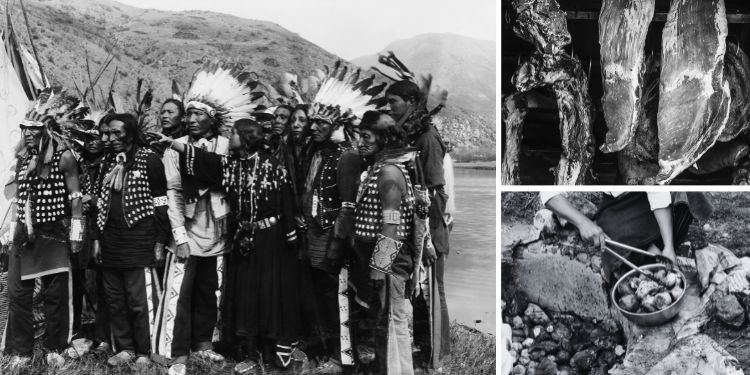 by Fergus Mason
by Fergus Mason
When Europeans first arrived in North America they often struggled to survive in the unfamiliar wilderness they encountered. For many early colonists, the help of the Native American peoples was a godsend. Because they were familiar with the plants, animals and climate of America, the natives had an amazing ability to find the food they needed, often without farming at all. The new arrivals learned some of those skills, and were able to keep themselves fed.
Of course the colonists quickly established farms, built towns and recreated the sophisticated European societies they’d come from. Quite soon, most of them were buying food as they needed it from markets, butchers and bakers. Agriculture and early food processing – by the 17th century beef and pork were being salted on an industrial scale, for example – meant food was available all year round.
The Native Americans lived a very different lifestyle. Most of them were nomadic or lived in small settlements. They usually lived off the land, as hunter-gatherers – and that meant sometimes they had more food than they could eat, while other times they struggled to find any at all.
To survive they had to find ways to preserve the surplus so it was available in the lean times. They did find ways to do that, and those methods can still be valuable to preppers today. Here are some of the main ways Native Americans prepared food for storage.
Drying
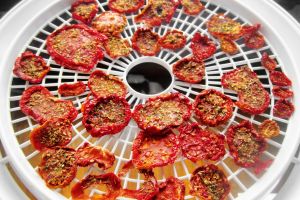 Almost all foods have a very high water content. Most fruit and vegetables are around 90% water by weight, and some of them are above 95%. Meat contains less moisture, but even then it’s usually somewhere between 70% and 75% water.
Almost all foods have a very high water content. Most fruit and vegetables are around 90% water by weight, and some of them are above 95%. Meat contains less moisture, but even then it’s usually somewhere between 70% and 75% water.
Related: How to Build a Solar Dehydrator
Generally this is fine; we need water to survive, and usually we get a lot of it from our food. It’s a different story if you’re trying to preserve food, though. We’re not the only ones that need water to survive; the bacteria and other organisms that make food spoil need it, too. More importantly, they don’t just need it to survive – they need it to reproduce. If you can remove most of the water you can slow their reproduction dramatically. Food that would spoil in a couple of days can last for months – or even years – if you can remove enough of the water.
Native Americans loved dried food. Not only could it be safely stored for much longer, but with the water removed it was a lot lighter. Many Native Americans were semi-nomadic, either following the game they hunted or moving between summer and winter areas. Dried food was more compact and, importantly, nowhere near as heavy; that meant they could carry much more of it.
Many preppers already know the benefits of drying food. I have a dehydrator in my kitchen, and as well as making jerky I use it to turn fruit into trail snacks, dry surplus herbs and dehydrate vegetables to add to home-made MREs.
Native Americans obviously didn’t have access to electric dehydrators, though, so instead they used the energy of the sun. Many tribes made drying racks from branches, and hung thin strips of meat or other food over them so the sun and air could evaporate their water content. Children and old people watched over the food as it dried, driving off insects and scavengers. If you’re drying food on a rack yourself a less manpower-intensive solution is to cover the rack with a mosquito net.
Another way to dry food is to lay it in the sun on flat stones. The stones can be heated in a fire first to speed up the process, but if they get too hot the food can end up cooked rather than dried.
Smoking
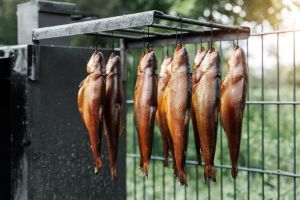 Smoking has many of the benefits of drying; it reduces the water content of food, slowing down the spoiling process. It can also coat or impregnate it with substances from the smoke that help to preserve it even better.
Smoking has many of the benefits of drying; it reduces the water content of food, slowing down the spoiling process. It can also coat or impregnate it with substances from the smoke that help to preserve it even better.
As a bonus, smoking also adds a distinctive flavor.
Native Americans smoked meat and fish, turning them into compact but tasty and nutritious foods that would last for months. They did this by building wooden racks, laying the food on them then leaving it in the smoke from wood fires for days.
Nomadic tribes had special tipis that were only used as smokehouses; tribes that built permanent villages used a hut or an underground room instead. If you don’t have a smokehouse, you can learn here how to build a cheap smokehouse in your backyard. The woods used were often selected for the flavor they gave the food, with hickory being a favorite.
When Native Americans butchered an animal, lean meat was usually dried. Ribs and fattier cuts were good candidates for smoking.
Rendering
Drying and smoking work best with lean meat; both processes will remove the moisture from meat, preventing spoiling, but the oils in fat can still turn rancid over time. If you make jerky you know how important it is to use the leanest meat possible, and the Native Americans knew this too.
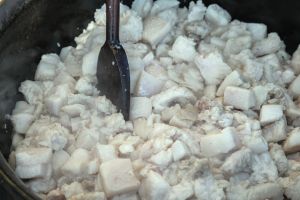
They didn’t want to waste the fat, though; it’s also a valuable source of energy and nutrients. When they butchered an animal, Native Americans would cook the fatty parts on a hot stone or in a pan to render the fat out, making it easier to store.
The most famous of their survival foods, pemmican, was made from rendered fat, pulverized dried meat and dried berries; it was high in protein and energy, and would last right through a long winter. Rendered fat was also used for cooking and medicinal poultices.
Salting
Salt is a very effective natural preservative, and Native Americans who lived near the coast were well aware of its value as a food preservative.
They collected salt by letting seawater evaporate in shallow ponds, then gathering and drying the salt it left behind.
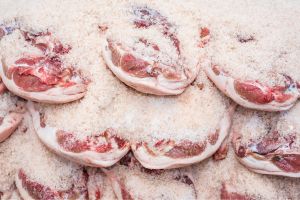 The Chickasaw people, who originally lived in the southeastern US, preserved meat by salting it – their name for it was Nipi hapayimma. Meat could be salted by cutting it in strips then rubbing the surface with salt as it dried.
The Chickasaw people, who originally lived in the southeastern US, preserved meat by salting it – their name for it was Nipi hapayimma. Meat could be salted by cutting it in strips then rubbing the surface with salt as it dried.
Alternatively it could be soaked in strong brine for around a month.
With the brine method herbs and spices were sometimes added to the solution to give the meat more flavor.
Freezing
Like salting, freezing wasn’t a method all Native Americans could use – but those who could, did.
 In winter, hunters would butcher the animals they killed then take the meat they didn’t plan to eat right away and bury it in snowdrifts. Once it had frozen, it would be removed from the snow. If the tribe was moving, the frozen meat could be wrapped in a hide and the cold air would keep it frozen until it was needed.
In winter, hunters would butcher the animals they killed then take the meat they didn’t plan to eat right away and bury it in snowdrifts. Once it had frozen, it would be removed from the snow. If the tribe was moving, the frozen meat could be wrapped in a hide and the cold air would keep it frozen until it was needed.
If they were settling in for the winter it could be stored in a pit or root cellar to protect it from animals.
Burial
Even today we preserve some foods by burying them. Potatoes are often stored in “clamps”; lay some straw on the ground, pile the potatoes (or other root vegetables) on it, cover them with more straw, then pile earth over the whole thing and dig a drainage ditch around it.
Native Americans also buried food for storage. Some tribes ate potatoes – these spread through the Americas before Europeans arrived – and most ate corn, squash and other vegetables.
All of these could be preserved for weeks, sometimes longer, by burying them in a pit lined with dry grass. Earth makes a great insulator, protecting buried food from the heat.
The modern world has many ways of preserving food. Any grocery store will sell us a wide range of dehydrated, canned and frozen food, and these are great options for building up your stockpiles.
But even your stockpile might run out during a prolonged crisis. That’s why it’s important for all of us to become as self-sufficient as possible. We don’t all need to become cattle ranchers, but keeping a few chickens and maintaining a small garden can provide an endless supply of food. For more information, check out this guide on how to create a year-round, self-sustaining garden and start living independently.
But when those modern resources are gone, and you’re looking for ways to preserve the food you’ve grown, hunted or foraged for yourself, the old Native American methods work just as well now as they did centuries ago.
If you know how to use them, you’ll be able to preserve food to get you through the winter and other hard times.
This article was inspired by ”The Lost Frontier Handbook”. You can get your hardcover copy HERE.png)
Anyone can join.
Anyone can contribute.
Anyone can become informed about their world.
"United We Stand" Click Here To Create Your Personal Citizen Journalist Account Today, Be Sure To Invite Your Friends.
Humic & Fulvic Liquid Trace Mineral Complex
HerbAnomic’s Humic and Fulvic Liquid Trace Mineral Complex is a revolutionary new Humic and Fulvic Acid Complex designed to support your body at the cellular level. Our product has been thoroughly tested by an ISO/IEC Certified Lab for toxins and Heavy metals as well as for trace mineral content. We KNOW we have NO lead, arsenic, mercury, aluminum etc. in our Formula.
This Humic & Fulvic Liquid Trace Mineral complex has high trace levels of naturally occurring Humic and Fulvic Acids as well as high trace levels of Zinc, Iron, Magnesium, Molybdenum, Potassium and more. There is a wide range of up to 70 trace minerals which occur naturally in our Complex at varying levels. We Choose to list the 8 substances which occur in higher trace levels on our supplement panel. We don’t claim a high number of minerals as other Humic and Fulvic Supplements do and leave you to guess which elements you’ll be getting.
Order Your Humic Fulvic for Your Family by Clicking on this Link, or the Banner Below.
Our Formula is an exceptional value compared to other Humic Fulvic Minerals because...
It’s OXYGENATED
It Always Tests at 9.5+ pH
Preservative and Chemical Free
Allergen Free
Comes From a Pure, Unpolluted, Organic Source
Is an Excellent Source for Trace Minerals
Is From Whole, Prehisoric Plant Based Origin Material With Ionic Minerals and Constituents
Highly Conductive/Full of Extra Electrons
Is a Full Spectrum Complex
Our Humic and Fulvic Liquid Trace Mineral Complex has Minerals, Amino Acids, Poly Electrolytes, Phytochemicals, Polyphenols, Bioflavonoids and Trace Vitamins included with the Humic and Fulvic Acid. Our Source material is high in these constituents, where other manufacturers use inferior materials.
Try Our Humic and Fulvic Liquid Trace Mineral Complex today. Be 100% Satisfied or Receive a Full Money Back Guarantee. Order Yours Today by Following This Link.






